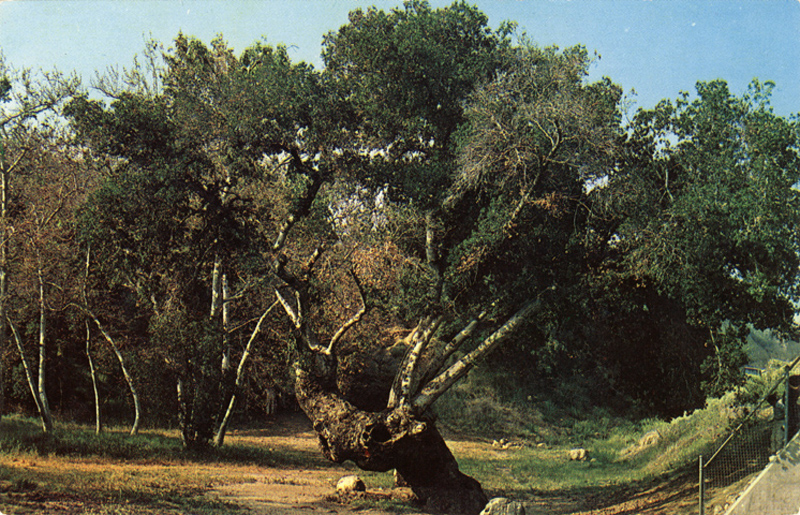Los Angeles Public Library, Valley Times Collection
Folks have a special place in their hearts for their hometown. Fond memories and sweet nostalgia grow in proportion to the amount of time spent away. Hometowns become the baseline or standard for other places we live, even as we realize that the distance of time and space have created a place in our minds that may not be reality. Even so, most of us are cultured enough to refrain from boorishly reminding others that "in [insert hometown name] we did things this way, or that way" implying that it was better. Maybe it was, maybe it wasn't.
But MY hometown . . . MY hometown is truly a special and unique place, and not because of the quaint memories stored in my own brain. After all, I lived there only during my teenage years, and it has been over 40 years since I actually called it home.
No, my hometown of Newhall-Saugus-Valencia California (now renamed Santa Clarita) is special because of momentous events, historical and innovative, that have occurred there. Most of these may be unknown to you, but in Southern California the area's rich history is well-known and is an important part of the state's past.
I'll start with an invention everyone will recognize. You know those baby carrots you buy in the bags in the produce section? Yup, developed in Newhall California by Mike Yurosek. He grew Bunny Luv carrots a few miles from my house. Mike was disturbed by the waste of "deformed" carrots that were too disfigured to be packaged into the pound bags sold in the grocery, so he refined them into these little nubs of carrots, and the rest is history.
Perhaps you have been to Sutter's Fort where gold was picked out of a stream by James Marshall in 1848, an decisive event that remade our nation. That discovery of gold in California is known by school children everywhere. Well guess what. Gold was first discovered in the Golden State in 1842. In Newhall California. Truth and legend say Francisco Lopez, a rider on the Spanish Rancho San Francisco (not to be confused with the city of SF) found gold flakes under an oak tree when he got off his horse to rest. A mini-gold rush ensued that has been left out of the history books. We local kids loved climbing in that oak tree--the Oak of the Golden Dream--which was polished smooth by generations of children who were fully aware of its significance.

Western America's first commercially successful oil well, No. 4, was drilled in 1876 in Pico Canyon, a few miles west of my house in a spot since called Mentryville. The amount of oil brought out of the area was huge, and Well No. 4 was not closed down until 1990 after 114 years in business. The Pioneer Oil Refinery, also a successful venture, was located a few miles across town.

"Pico Canyon Well No. 4"
by Carleton E. Watkins (per Santa Clarita Valley history site http://www.scvhistory.com/scvhistory/ch1000.htm ) - Los Angeles Public Library http://catalog1.lapl.org/cgi-bin/cw_cgi?fullRecord+8510+968+46690+2+0.

Pioneer Oil Refinery on Pine Street, about 2014
In the 1920s St. Francis Dam was built in San Francisquito Canyon, about 10 miles from my house, as part of a water project to slake the thirst of Los Angeles. In 1928 the dam burst and millions of gallons of water swept 400 people to their deaths. It was the largest man-made disaster in California history and ruined the career of the brilliant engineer, William Mulholland. [photos are displayed on the links to previous posts]
Tiburcio Vasquez (1835-1875) was a notorious rustler and bandit who terrorized and murdered storekeepers, ranchers and travelers all over the state. He hid out in an area of convoluted rock formations, now called Vasquez Rocks, in the northeastern section of our valley. It has long been a fascinating and favorite place for locals to hike and climb, and a movie set for Westerns and science-fiction films (John Wayne and Star Trek!).

bad guy Tiburcio Vasquez
Beale Cut was a passage cleaved through a mountain on the southern end of Newhall in 1868 by Chinese laborers under the direction of General Edward Beale. Pre Beale Cut, the rugged road from Los Angeles to points north (mainly San Francisco) was treacherous and usually impossible to ascend without the use of a windlass. Beale's slice through the mountain made wagon and stagecoach traffic safe and do-able and opened up a new era of commerce and communication. This route had been pioneered a hundred years before by Catholic friars and military men. After 1868 merchants and the Butterfield Stage made regular use of it. Modern Scouts and schoolchildren, hikers and travelers have marveled at this 19th century engineering feat, and have thrilled at the marine fossils exposed in the vertical walls of the cut. Hmmm, I wish I knew what happened to my fossil collection.

Beale Cut, also called (erroneously) Fremont Pass
[Part 2 on Tuesday]

No comments:
Post a Comment